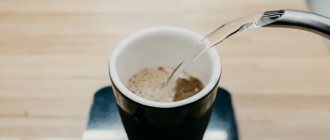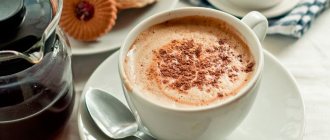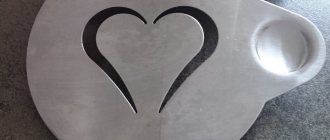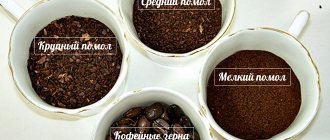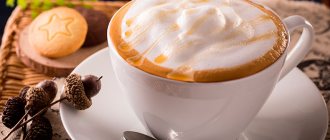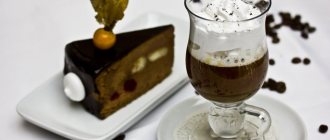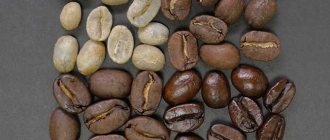Chocolate flavored coffee is a famous drink. Coffee and chocolate harmonize very well with each other. The bitterness of coffee beans becomes virtually invisible when mixed with the latter. Having started its journey in the countries of the Latin American region, it reached European countries and became the favorite drink of many coffee lovers. The most famous chocolate-coffee drink today is called mochaccino.
The oldest existing legends of coffee date back to Ethiopia, where this beautiful plant was one of the first to be discovered. At first, gourmets paid attention only to the leaves. But then drink lovers began to take a closer look at the green beans; when roasted, they become dark in color.
Marocino coffee
Morocchino coffee
or
Marocino
is a thick espresso coffee with delicate milk foam and luxurious chocolate cocoa.
One serving of Marocino coffee can both wake you up and inspire you. For centuries, Italians have mixed coffee, chocolate and milk to make coffee drinks. The oldest recipes for coffee with chocolate date back to the 18th century. Morocchino is a sweet coffee from Alessandria, where it was first served at the Carpano bar. The famous Borsalino hat factory was located in Alessandria. It was from this factory that the hats worn by many famous and illustrious heads (including Indiana Jones and Michael Jackson) were born. These hats had a distinctive brown stripe on the inside called marocino. In honor of the magnificent hats, a coffee with a layer of cocoa reminiscent of this stripe was created. Today this coffee is popular throughout Italy, although in the north it can be found under a slightly different name - espressino
. Morocchino is distinguished by its modest size and serving method - it is served in a small transparent cup with a metal handle so that all the layers are visible.
How to make Marocchino coffee
Ingredients:
- Medium or dark roast coffee – 4 tsp.
- Fin for making coffee – 1 pc.
- Hot water – 150 ml
- Cocoa powder – 1-2 tsp.
Prepare very strong coffee - espresso. This can be done in a coffee machine by pouring 4 teaspoons per 150 ml of water. This volume is enough for 2 servings. Pour the finished coffee into a transparent cup. Sprinkle with cocoa powder. Foam the milk and carefully place the milk foam on top of the expresso with cocoa powder. Sprinkle dark cocoa on top. Marocino coffee is served in a glass cup with a metal handle, observing the layers of the drink before stirring and drinking.
History of Flavored Coffee
There is a lot of mystery surrounding the history of flavored coffee. Different peoples sincerely consider this drink to be their invention. But many methods have been used for centuries, and it is not known for sure who first came up with the idea of preparing coffee with different additives.
Nuts and berries could have been added to coffee by ancient tribes who discovered this drink to the world. It is known for sure that the Arabs who lived in the territory of modern Yemen have long prepared coffee with the addition of cinnamon, cardamom, vanilla and other spices.
Today, many of us buy flavored coffee in coffee shops, but there it often gets extra flavor from syrups. Industrially produced flavored coffee can be prepared at home and get the same great results.
Moccacino coffee
Moccacino coffee
– a type of
latte coffee with chocolate flavor
and original presentation. It is also called mochaccino or mocha latte. The name of this drink comes from the city of Mocha (or al-Maha) in Yemen, which was the main market for coffee from the 15th to the 18th centuries.
Moccacino coffee recipe
There are several recipes for making moccacino. We will tell you about the simplest moccacino recipe.
Ingredients for making moccacino coffee:
- Medium or dark roast coffee – 4 tsp.
- Fin for making coffee – 1 pc.
- Hot water – 220 ml
- Cocoa powder – 1-2 tsp.
How to make moccacino coffee:
Prepare 120 ml espresso in a fina or coffee machine. This volume is enough for 2 servings. Pour chocolate syrup made from cocoa into a 220 ml tall glass. To do this, you can use a 1 to 1 ratio of dark cocoa powder for dark chocolate connoisseurs or hot chocolate if you like milky, creamy chocolate. Pour in 60 ml of espresso in the next layer. Pour hot or cold milk in a thin stream. Top with whipped cream and a generous drizzle of chocolate syrup. Connoisseurs of an even more chocolatey taste will definitely like it if the finished chocolate mocha is powdered with dark cocoa powder. Mocha coffee is served with a straw, which is used to stir the layers of the drink and drink.
What kind of chocolate is used for making
Cocoa powder is often used to make moccacino, although some people prefer to add chocolate syrup instead. You can also use dark, milk or white chocolate.
In order to emphasize the exquisite bitterness of espresso, it is recommended to choose chocolate with a cocoa content of 70% or more. This type is the most natural and least caloric; it contains enzymes and minerals that add beneficial properties to the finished drink.
When it is necessary to soften the bitterness or sourness of espresso, use milk chocolate. It gives the dessert a creamy taste.
An exotic option that has found its fans is coffee with white chocolate.
Bavarian coffee
To make Bavarian coffee you will need:
- An espresso shot or other strong coffee can be prepared as in previous espresso recipes in a fine espresso or in the classic way in a coffee machine.
- Chocolate syrup, cocoa powder or hot chocolate.
- Lemon – 1-2 slices (one of them for decoration). Lemon can be replaced with orange.
- Grated chocolate or dark cocoa powder.
How to make coffee the Bavarian way
Prepare strong fine coffee or espresso in another familiar way. Take a tall coffee glass. Pour 1-2 tsp onto the bottom. ready-made chocolate syrup, or prepare it yourself by mixing 1-2 tsp. cocoa powder with an equal amount of hot water. Hot chocolate from the BAO brand is ideal for making homemade chocolate syrup. It simply dissolves in hot water and you do not need to worry about the safety of the opened chocolate syrup. Hot chocolate in dry powder is not demanding on storage conditions and does not require at least a refrigerator. Take a lemon wedge and squeeze some into a cup on top of the chocolate syrup. Carefully pour the espresso into the glass with the chocolate syrup. Add a little water if you prefer a weaker coffee. The more water, the softer the drink. Add a slice of lemon and sprinkle the resulting drink with grated chocolate or quality cocoa powder. We recommend using 100% natural Extra Dark cocoa powder in its pure form or cocoa with the addition of natural vanilla. The drink is ready. This is one of the Bavarian coffee recipes, you can adapt it to your taste, for example, replace the lemon with orange or add a little cinnamon.
This unique coffee aroma!
« Back to the list of articles
The unique aroma of coffee... Bright and invigorating, gentle and bold, soft and inspiring... for everyone. Have you ever wondered what exactly your favorite drink smells like, what notes predominate in it? Chocolate, fruit, wood - experts boldly use these concepts when describing this or that coffee aroma. Let's try to understand all the variety of aromatic components of the coffee smell.
Aroma can also be expressed in taste, but taste and aroma do not necessarily work in tandem. For example, you may recognize tobacco or caramel notes in a coffee aroma, but not notice them at all in the taste.
So, let's begin. First - the most common coffee aromas, then unusual ones.
Chocolate
. Actually, there are very noticeable notes of dark and milk chocolate, or cocoa powder. This aroma is sometimes called sweet. Most often, the aftertaste will be chocolate.
Caramel
. The smell and taste of caramelized (not burnt) sugar.
Fruity/citrusy
. Taste and aroma of fruits or berries. It often happens that coffee with pronounced citrus notes in the aroma has high acidity.
Floral
. Easily perceptible, similar to the unobtrusive fragrance of flowers such as honeysuckle, dandelion, jasmine. It is very rarely bright and intense.
Herbal
. Reminds me of a freshly cut lawn, green foliage and unripe fruit.
Grain/malt
. The aroma and taste of raw or toasted grains (such as barley or wheat), malt extract and freshly baked bread.
Walnut
. The smell and taste of fresh nuts (with the exception of almonds).
Woody
. Very reminiscent of the smell of dry wood, an oak barrel, cardboard or paper.
Ashen
. The smell of an ashtray, a smoker's fingers, a freshly cleaned fireplace. Does not count as negative. Most often used by tasters to describe the degree of roasting of coffee beans.
Tobacco
. Quite intense notes of tobacco (not burnt) in the smell and taste of the drink.
Burnt/smoky
. Similar to the smell of burnt food. May be associated with the smell of burnt wood. The term is used to describe coffee that is dark roasted or over-roasted.
Wine
. The combination of aroma and taste sensations is like after a glass of good wine. This is usually used to describe the smell of strongly acidic coffee with a fruity aftertaste. Does not apply to sour and yeasty aromas.
"Animal"
. This is not aromatic musk, but the smell of wet skins, fur, leather. Not necessarily negative, but rather used to describe the strong notes of the drink.
Zemlyanoy
. The characteristic smell of freshly dug wet soil and humus. Often associated with mold or raw potatoes. Considered an undesirable note in coffee.
"Rubber"
. This is how coffee smells like hot tires. The smell of rubber is not a negative sign, but characterizes the strong, easily recognizable aroma of some types of coffee.
Spicy
. Typical aroma of sweet spices such as cloves, cinnamon, allspice. Not used to describe coffee with the smell of hot spices (hot pepper, oregano).
The above list was compiled by the International Coffee Organization and is far from complete. But it is not at all necessary to interpret the aroma of your favorite drink in one way and in no other way. Perhaps you can find and describe some other unique notes. And in order to understand and experience all the subtle nuances of coffee aroma, we advise you to drink fresh, just ground and brewed coffee, and try to pamper yourself with a variety of “opposite” varieties, with dissimilar taste characteristics.
We suggest starting with Vietnamese coffee with a pronounced chocolate aroma and aftertaste, which you can purchase in our store.
Turkish coffee in Romanian style
To make Turkish coffee, it is better to use finely ground coffee.
Ingredients:
- Finely ground coffee – 1 tsp.
- Cocoa powder – 1 tsp. If you like the subtle chocolate taste and aroma of cocoa, then when using Vietnamese extra dark PV cocoa, you can use a smaller amount, for example, ½ tsp.
- Sugar or powdered sugar
- Vanillin – 1 pinch (if you use Extra Dark PV cocoa in a jar, then vanilla is not required, because this cocoa powder contains natural vanilla).
- Water – 1 cup (220 ml).
How to make coffee the Romanian way
Mix all the dry ingredients except vanillin in a pot, add water, heat to a boil, but do not let the coffee boil. The important thing is to just wait until the grounds start to rise. Remove the Turkish coffee from the heat, add vanillin, stir and after a couple of minutes pour into your favorite cup.
Descriptors
Indeed, the flavor and aroma characteristics of coffee are richer than those of wine. But it makes no sense to describe them in scientific language: we will never choose coffee that way. Therefore, to characterize the taste and aroma of coffee (as well as wine), descriptors are used - units of description of taste. It is them (usually three or four) that we can see on a pack of grain.
The connection between a descriptor and the product it names is approximately the same as between a letter and a sound - quite conditional. Let's imagine, for example, an apple: what could be simpler? But some will remember the aroma of white wine from grandma’s dacha, some will remember the bright sweet Fuji, and some will remember the green and sour Granny Smith. You can also remember charlotte, jam, cider, flavored caramel... And in all this we recognize the taste and aroma of an apple (I prefer the word flavour, which is not yet in the Russian language, but it perfectly combines these two concepts).
Photo by Yulia Dirdova
What is the difference between taste and aroma
We perceive taste through receptors located on the tongue.
There are five basic tastes: sweet, salty, sour, bitter and umami - the taste of high-protein foods. We sense aroma through the sense of smell: orthonasal - through the nose, and retronasal - when aroma molecules enter the nasal cavity through the pharynx. We distinguish the tastes of food precisely thanks to the retronasal sense of smell: to check this, you can chew a piece of any food with your nose pinched and feel the “pure taste”, and then unclench it - and be surprised at how bright the aroma of food becomes in your mouth. All these products are united by a certain “apple-ness”, and it is actually not abstract - it is a complex of chemical compounds that create a certain recognizable flavor. When we encounter the same chemical compounds in brewed coffee (the most obvious is malic acid), we remember that we have already tried something similar and call it an apple. But coffee contains not only malic acid, but also citric, tartaric, acetic... Certain combinations of these acids in combination with other substances (for example, sugars, essential oils) create the perceived tastes and aromas that we associate with specific products. For example, raspberries contain the same acids as apples - malic, tartaric, citric - but in a different ratio, so in one coffee we will feel the acidity of raspberries, and in another - apple. It works the same way with citrus, nuts, spices, and other wonderful (and not so wonderful) things you find in the taste of coffee. Therefore, descriptors are not the imagination of producers: what we find in the taste and aroma of a drink objectively exists in the chemical composition of the grain. However, you should not read the descriptors “raspberry” or “apple” as a direct reference to raspberry or apple: the descriptor only indicates that in this coffee, due to its chemical composition, you can smell something similar to these products (to a greater or lesser extent). . Or you may not feel it - it all depends on your taste experience and memory, on your attention to what is currently in your cup, and even on how exactly you prepared the drink.
Photo by Yulia Ovchinnikova
Tiramisu - coffee dessert with chocolate cocoa
Tiramisu comes from Italy. Literally translated, its name sounds like “cheer up.” This famous coffee dessert with cocoa is popular all over the world due to its ease of preparation, lightness and impeccable taste. A step-by-step recipe for making tiramisu with mascarpone can be read in more detail in a separate recipe, to which we dedicated a separate article.
Coffee and chocolate taste go well together. Did you know that there is coffee with chocolate flavor, but without the addition of cocoa and chocolate? The world-famous Kopi Luwak coffee and traditional Vietnamese coffee have a chocolate taste and aroma, for which they are appreciated and loved all over the world. The taste and aroma of chocolate gives coffee beans a special roast with a blend of different degrees of roasting and varieties of coffee beans. Sometimes natural spices and coconut oil are used in traditional Vietnamese roasting for more intense flavors. For Vietnamese coffee, the recipe for making chocolate coffee is always simple - just prepare the coffee in the usual way. Choose Vietnamese coffee with chocolate flavor and try making chocolate coffee using our recipes. Share your opinion. We greatly appreciate your feedback.
Enjoy your chocolate and coffee tasting. Your VietVam team
Types of Flavored Coffee
Whether you prefer to drink your coffee in the morning, afternoon or evening, we have a flavored coffee to suit every moment of your busy day.
Which one will you like? Choose!
Vanilla flavored coffee
Do you like to laze on the beach in the summer while enjoying vanilla ice cream? But what if the weather is cold and dreary, and a trip to the sea is out of the question?
In this case, we recommend you coffee with vanilla flavor, which will give you the nostalgic taste of summer ice cream. A nice bonus: regardless of the weather, without leaving home and with much less calories consumed!
We are confident that you will be able to find a suitable option with us. It's a great alternative to sweet treats, and we even recommend this coffee for an evening dessert after dinner with friends!
Irish cream liqueur flavored coffee
Irish Cream Coffee is a great drink, with the taste of your favorite liqueur, but without the alcohol.
Irish cream is popular all over the world, but its alcoholic component is not always appropriate in life. You will be able to appreciate all its exquisite notes, enjoy the wonderful aftertaste, but avoid an unpleasant headache in the morning!
Unlike real Irish Cream, flavored coffee is a socially acceptable drink that you can use to start (not end!) your day. Ideal for breakfast with a croissant (or maybe two?)
Coffee with hazelnut flavor
Hazelnut is, by all accounts, the most common flavor for flavored coffee. It can be found on the menus of stores and coffee shops around the world.
Coffee with hazelnut aroma, which is offered by our online store Kofe.ru, is nothing less than quality and excellent taste in every sip. This is an amazing nutty aroma and excellent coffee for any part of your work or weekend day. The choice is yours!
Chocolate flavored coffee
This drink is a real, hedonistic pleasure after a long, tiring day. It is ideal for the evening, although, like hazelnut-flavored coffee, it is good at any time of the day.
Coffee with chocolate flavor will give you a real delight, because its rich, bright and slightly creamy taste will excite you with every sip. The tempting aftertaste will make you a real fan of this coffee.
But, of course, you shouldn’t limit yourself to flavored coffee when our online store Kofe.ru offers more than a hundred different types of coffee. Our extensive range is sure to offer you something to suit your taste.
